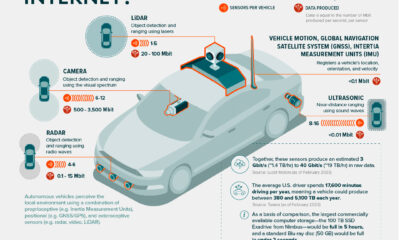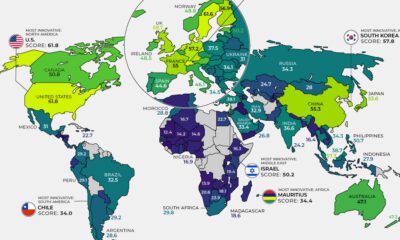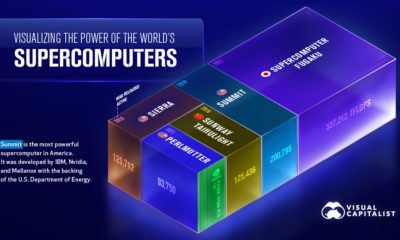In the late 20th century, it was the emergence of Design Thinking that upended how architects, engineers, and industrial design organizations made decisions about how to make new things. Now, the rapid pace of technological advancement has brought forth a new design methodology that will again forever alter the course of design history. Computational design, which takes advantage of mass computing power, machine learning, and large amounts of data, is changing the fundamental role of humans in the design process.
Designing With Billions of Data Points
Today’s infographic comes to us from Schneider Electric, and it looks at how the future of design will be driven by data and processing power. While computational design is still a term with no real consensus, attempts to define it do have overlap: Parameter setting Algorithmic, “rules-based” code can be applied as constraints to test a wide variety of computer-driven designs 3d modelling and visualization tools Complex 3d models can allow designers to test and create simulations for new ideas Processing power Using vast amounts of computational power and automation to make designs not before possible Designing with data Applying big data and powerful algorithms to create new designs Generative design By creating, testing, and analyzing thousands of design permutations, this approach mimics mother nature’s evolutionary path to design While designers traditionally rely on intuition and experience to solve design problems, computational design is a new design methodology that can literally produce hundreds or thousands of design permutations to find the absolute best solution to a problem.
The Shifting Roles of Humans and Computers
Throughout history, humans have shaped the world with design. But now that artificial intelligence is superior in taking on specific roles within the design process, humans will move towards shaping the things that shape the world. Designers will be relinquishing control to technology, so that humans can do what they do best. In other words, in the future, designers will work less on designing – and instead will supervise, mentor, and set the parameters for computational designs. Human designers would also interact with a broader group of stakeholders as additional inputs and the frequency of interactions increase.
A New Design Landscape
Disruption to traditional design methods brings more questions than answers:
How will this change the value chain for design companies and professionals? Will AI-enabled computational design tools take the “craft” out of design? If automated design “assets” become commercial commodities, will that create new product and revenue channels for businesses? Who will own and manage all of this data, and does this create new roles and opportunities for companies?
As we give machines more design autonomy, it will be interesting to see how this literally changes the shape and design of objects that make up the real world. on But fast forward to the end of last week, and SVB was shuttered by regulators after a panic-induced bank run. So, how exactly did this happen? We dig in below.
Road to a Bank Run
SVB and its customers generally thrived during the low interest rate era, but as rates rose, SVB found itself more exposed to risk than a typical bank. Even so, at the end of 2022, the bank’s balance sheet showed no cause for alarm.
As well, the bank was viewed positively in a number of places. Most Wall Street analyst ratings were overwhelmingly positive on the bank’s stock, and Forbes had just added the bank to its Financial All-Stars list. Outward signs of trouble emerged on Wednesday, March 8th, when SVB surprised investors with news that the bank needed to raise more than $2 billion to shore up its balance sheet. The reaction from prominent venture capitalists was not positive, with Coatue Management, Union Square Ventures, and Peter Thiel’s Founders Fund moving to limit exposure to the 40-year-old bank. The influence of these firms is believed to have added fuel to the fire, and a bank run ensued. Also influencing decision making was the fact that SVB had the highest percentage of uninsured domestic deposits of all big banks. These totaled nearly $152 billion, or about 97% of all deposits. By the end of the day, customers had tried to withdraw $42 billion in deposits.
What Triggered the SVB Collapse?
While the collapse of SVB took place over the course of 44 hours, its roots trace back to the early pandemic years. In 2021, U.S. venture capital-backed companies raised a record $330 billion—double the amount seen in 2020. At the time, interest rates were at rock-bottom levels to help buoy the economy. Matt Levine sums up the situation well: “When interest rates are low everywhere, a dollar in 20 years is about as good as a dollar today, so a startup whose business model is “we will lose money for a decade building artificial intelligence, and then rake in lots of money in the far future” sounds pretty good. When interest rates are higher, a dollar today is better than a dollar tomorrow, so investors want cash flows. When interest rates were low for a long time, and suddenly become high, all the money that was rushing to your customers is suddenly cut off.” Source: Pitchbook Why is this important? During this time, SVB received billions of dollars from these venture-backed clients. In one year alone, their deposits increased 100%. They took these funds and invested them in longer-term bonds. As a result, this created a dangerous trap as the company expected rates would remain low. During this time, SVB invested in bonds at the top of the market. As interest rates rose higher and bond prices declined, SVB started taking major losses on their long-term bond holdings.
Losses Fueling a Liquidity Crunch
When SVB reported its fourth quarter results in early 2023, Moody’s Investor Service, a credit rating agency took notice. In early March, it said that SVB was at high risk for a downgrade due to its significant unrealized losses. In response, SVB looked to sell $2 billion of its investments at a loss to help boost liquidity for its struggling balance sheet. Soon, more hedge funds and venture investors realized SVB could be on thin ice. Depositors withdrew funds in droves, spurring a liquidity squeeze and prompting California regulators and the FDIC to step in and shut down the bank.
What Happens Now?
While much of SVB’s activity was focused on the tech sector, the bank’s shocking collapse has rattled a financial sector that is already on edge.
The four biggest U.S. banks lost a combined $52 billion the day before the SVB collapse. On Friday, other banking stocks saw double-digit drops, including Signature Bank (-23%), First Republic (-15%), and Silvergate Capital (-11%).
Source: Morningstar Direct. *Represents March 9 data, trading halted on March 10.
When the dust settles, it’s hard to predict the ripple effects that will emerge from this dramatic event. For investors, the Secretary of the Treasury Janet Yellen announced confidence in the banking system remaining resilient, noting that regulators have the proper tools in response to the issue.
But others have seen trouble brewing as far back as 2020 (or earlier) when commercial banking assets were skyrocketing and banks were buying bonds when rates were low.













